
Ascent Log
| Climb | Type | Suggested Grade | Date of Ascent | Notes |
|---|---|---|---|---|
| Gill Problem | Boulder | V9 | 1959 | |
| The Groove | Boulder | V10 | 1978 | |
| Thimble Overhang | Highball | 5.12a | 1961 | |
| Final Exam | Route | 5.11a | 1960 | |
| The Gill Crack | Route | 5.12a | 1960s |

Climbing Career
Early Life & Education
When you start searching for John Gill on the internet, you’ll be left in awe. This man has done it all. He was not only a great climber, but also a great gymnast and a mathematician.
Born in February 1937 in Tuscaloosa, Alabama, he spent his childhood in several cities around the Southern US, ending up in Atlanta, Georgia, where he attended Georgia Tech until 1958, when he got his degree in mathematics.
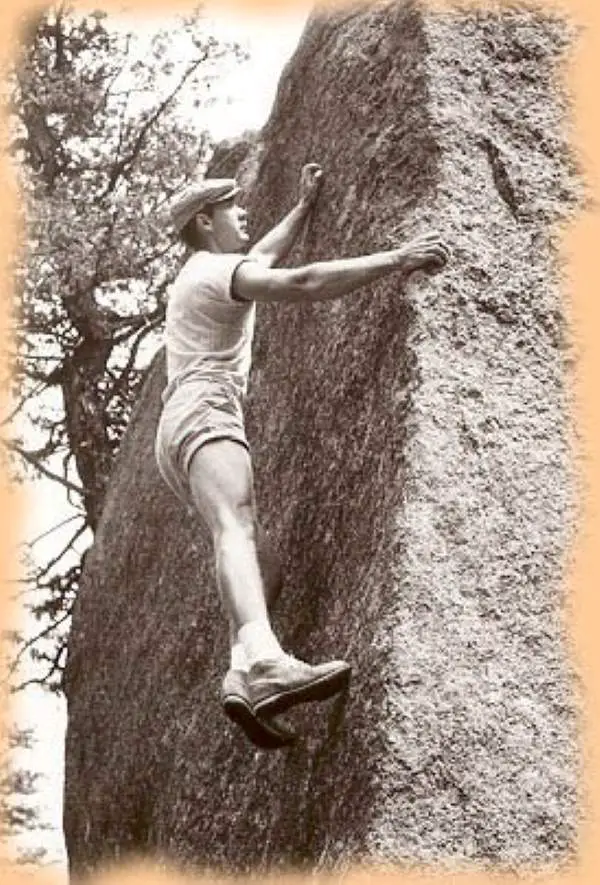
After graduating from Georgia Tech, he enrolled in a graduate program in meteorology at the University of Chicago. After all these, he served in the US Air Force, and he resigned from the Reserves in the mid-1960s.
In 1964, he earned a master’s degree in mathematics from the University of Alabama and worked as a mathematics instructor at Kentucky’s Murray State University.
If that wasn’t enough, from 1967 until 1971 he enrolled in further graduate studies, earning his PhD in Classical Complex Analysis.
While being a badass climber and maybe one of the coolest math professors in history, Gill wrote around thirty research papers on the analytic theory of continued fractions, complex functions, and linear fractional transformations.
Learning the Ropes
John Gill began rock climbing around the age of 16 in northern Georgia. He started as a trad climber. Later, while at Georgia Tech, he enrolled in the college’s gymnastics team and started “bouldering” around campus as a form of training.
The man was a modern-day Hercules; in the 1950s, he was able to make half a dozen one-arm pull-ups per arm, multiple one-finger one-arm pull-ups, and one-arm front levers. How’s that for a training challenge at the gym?
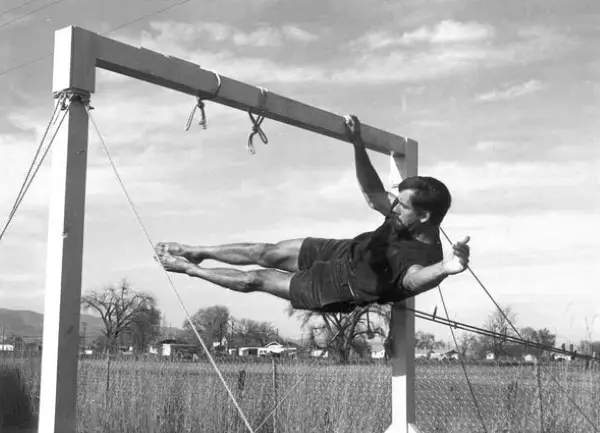
Because the V scale was not invented yet, Gill climbed at an extremely hard level without even knowing how much it would take for his problems to be repeated. And how did he do that? Well, keeping it old school (which during that time was only the norm), without crash pads or climbing shoes, as the Boreal Fire will appear on the market only in 1979.
Also, due to his gymnastics background, John brought a small but essential innovation into rock climbing, he introduced the use of chalk to keep his hands dry and grippy.

Notable Ascents
The Gill Problem [Red Cross Rock]
First ascended by the man himself in 1959, the Gill Problem is maybe the first V9 boulder problem in the world. In a time when bouldering grades were not a thing, Gill did this route after seeing many strong climbers trying to get to the top hold and failing.
Located in the Grand Teton Mountains, the Gill Problem sits in the exact middle of Red Cross Rock.
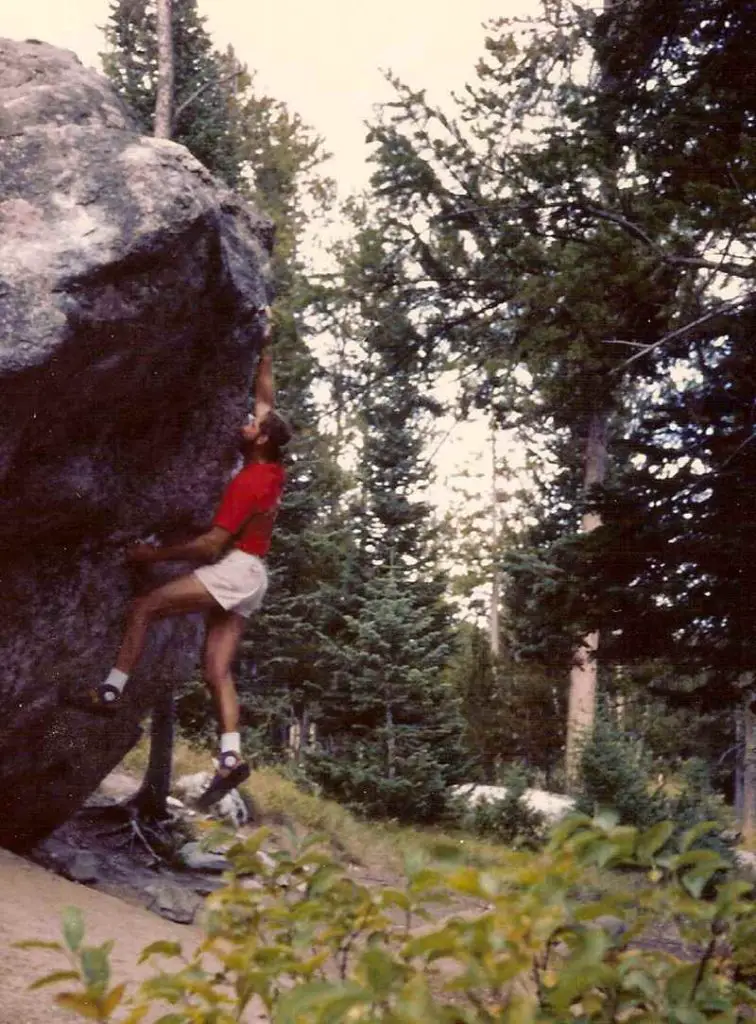
At that time, the start was on a smooth irregularity in the rock, with a horizontal hairline crack on the top. John started by placing his left toe on a small hold and reached for a large hold in the middle with his left hand, followed by toeing off the ground with his right foot. He called this technique “swinging lieback”, which was not a jump but a big dynamic move.
Because the move was really hard and he couldn’t do it every time, John chipped off a bit of the rock in the hairline crack just to have a fingertip hold on the right hand.
Over time, other climbers altered the rock by chipping bigger footholds which now makes the problem considerably easier than it used to be.
Thimble Overhang
Located in The Needles of South Dakota, the Thimble Overhang is a 10-meter 6C highball considered back then a free solo route. Since Gill treated the climb as a free solo, it has a YDS grade of 5.10. As for most of the Gill routes, this is one of the first 5.10 routes in America and maybe the world.

As John Sherman in Stone Crusade said, when Gill climbed The Thimble in 1961, it was the hardest route of its length in America.
As it is close to a daredevil act, Thimble wasn’t repeated for 20 years. The reasons are multiple, including the height, the complexity of the moves, and also the fact that when John made the first ascent, a guardrail was placed at the foot of the rock, adding an extra layer of danger in case of a fall.
The Groove
Considered the first 7C+ (V10) boulder problem in the world, John Gills’ The Groove is located near Pueblo, Colorado.
It’s not a line riddled with tiny holds but rather a strong one that requires resistance and some strong biceps.
John made the first ascent in 1978, and according to him, climbing it required learning some great technical moves. Described as a strong-arm route, The Groove involved techy moves, great strength, and momentum.

Legacy
The Use of Chalk
Around 1954, Gill was the first climber to use chalk while training on the campus of Georgia Tech. As a member of the gymnastics team, he had easy access to the white stuff and was also aware of the advantages it could bring in rock climbing.
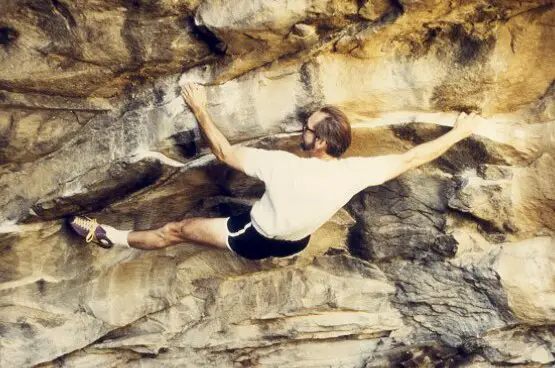
It took a while to make it a thing, as some climbers considered using chalk as cheating, but John’s hard climbs proved that it could really give you an edge in solving some of his most challenging problems.
The First Bouldering Grades
Before the V-grade became a thing in 1991, John Gill introduced his own bouldering grading system, the B-Scale. It was very simple and used three grades, B1, B2 and B3.
Maybe due to its simplistic or limited nature, the B system didn’t become widespread in the US and was taken over by the V-scale.
A powerhouse and, frankly, one of my rock climbing heroes, John Gill is one of the most important curators of climbing culture. With essays like The Art of Bouldering, he pushed an activity often overlooked by athletes of his time to a veritable standalone sport that even features in the Olympic Games.
John is a member of the American Alpine Club and received in 2008 the annual Robert & Miriam Underhill Award. Now aged 86, he retired from climbing, but he can still be found at his local park working on his pull-ups.
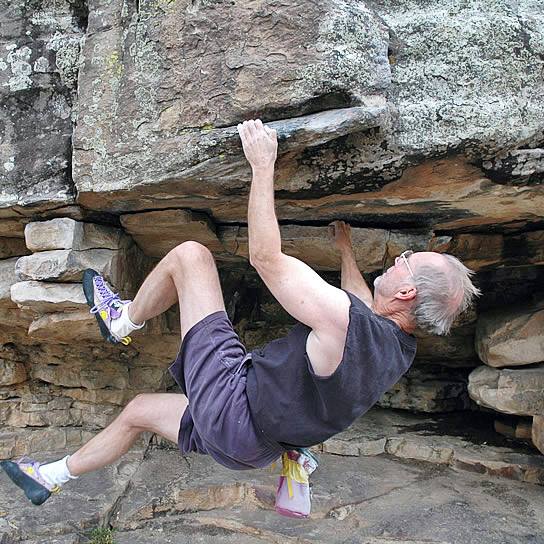

Video Library



